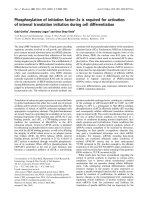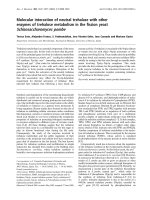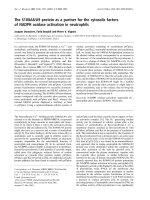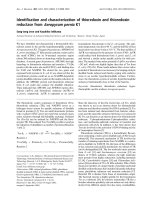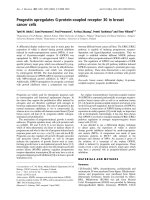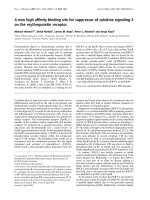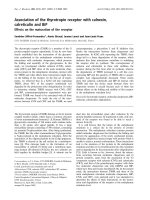Báo cáo y học: "Video-assisted mediastinoscopic transhiatal esophagectomy combined with laparoscopy for esophageal cancer" pdf
Bạn đang xem bản rút gọn của tài liệu. Xem và tải ngay bản đầy đủ của tài liệu tại đây (399.46 KB, 5 trang )
RESEARC H ARTIC L E Open Access
Video-assisted mediastinoscopic transhiatal
esophagectomy combined with laparoscopy
for esophageal cancer
Bin Wu
1†
, Lei Xue
1†
, Ming Qiu
2
, Xiangmin Zheng
2
, Lei Zhong
1
, Xiong Qin
1
, Zhifei Xu
1*
Abstract
Background: Minimally invasive transhiatal esophagectomy for esophageal cancer includes mediastinoscopic and
laparoscopic transhiatal esophagectomy. It is inadequate in both two techniques. It is impossible to dissect the
lower esophagus with single mediastinoscopy or the upper and middle esophagus with single laparoscopy. We
use mediastinoscopy combined with laparoscopy to dissect the whole esophagus and stomach including lymph
node dissection. In addition, laparoscopic gastric mobilization leads to less trauma than an open gastroplasty.
Methods: 40 cases of video-assisted mediastinoscopic transhiatal esophagectomy were performed and divided
into two groups.32 patients were received surgical therapy of single mediastinoscopic esophagectomy with open
gastroplasty in group A, while 8 patients were received surgical therapy of mediastinoscopic esophagectomy
combined with laparoscopic lower esophageal and gastric dissection in group B. The perioperative complications
were recorded.
Results: Video-assisted mediastinoscopic transhiatal esophagectomy was performed successfully both in group A
and B. It suggested that mediastinoscopy combined with laparoscopy be better than single mediastinoscopy
because of less blood loss, less pain, shorter ICU stay and complete lower mediastinal lymph nodes resection.
Conclusions: Video-assisted mediastinoscopic transhiatal esophagectomy combined with laparoscopy is a safe and
minimally invasive technique with whole esophagus and mediastinal lymph node dissection in the clear
visualization of the mediastinum, reducing the abdominal trauma.
Background
Since the late 1980 s, minimally invasive surgical techni-
que has been widely used in diagnosis and treatment of
chest disease. The overall advantages of minimally inva-
sive surgery are to complete the same operation through
small incision avoiding the trauma of open operati on.
Tradi tional operation for esophageal carcionma requires
thoracotomy and laparotomy, which is one of the most
complex operations in gastrointestinal surgery. The
trauma is large and the morbidity of surgical complica-
tions is high. So the surgeons are searching for a mini-
mal invasive operative method instead of traditional
esophagectomy.
The basic us es of mediastinoscopy include mediastinal
mass biopsy, lymph node biopsy for the diagnosis. With
the development of endoscopic technology, the applica-
tive area of medias tinoscopy expanded. By now video-
ass isted mediastinoscopy can be used for the separation
of esophageal tumor. Esophagectomy via mediastino-
scopy was firstly reported by Buess [1] in 1990. The
advantage of video-assisted mediastinoscopic transhiatal
esophagectomy is not only to avoid thoracotomy and
reduce bleeding compared with traditional transhiatal
esophagectomy, but also to resect mediastinal lymph
node thoroughly. Also, laparoscopic techniques have
developed rapaidly in recent years, which can be used to
mobilize the stomach and to mobilize the lower esopha-
gus via hiatus. A combination of mediastinoscopy and
laparoscopy could be used for complete esophagectomy
and reconstruction of digestive tract, which can replace
* Correspondence:
† Contributed equally
1
Department of Cardio-Thoracic surgery, Changzheng Hospital, Second
Military Medical University, 415 Fengyang Road, Shanghai, 200003, PR China
Full list of author information is available at the end of the article
Wu et al. Journal of Cardiothoracic Surgery 2010, 5:132
/>© 2010 Wu et al; licensee BioMed Central Ltd. This is an Open Access article dist ributed under the terms of the Creative Comm ons
Attribution License (http://creativecommons.o rg/licenses/by/2.0), which permi ts unrestricted use, distribution, and rep roduction in
any medium, provided the original work is properly cited.
the single mediastinoscopic esophagectomy to reduce
trauma and postoperative complications[2].
Methods
General data
From March 2004 to November 2008, 40 cases of video-
assisted mediastinoscopic esophagectomy were per-
formed in our Department. All the surgical treatments
were completed by the same group of surgeons. All the
patients had been diagnosed and s taged preoperatively
by endoscopy with biopsy, X-ray of the digestive tract
with barium swallow, CT scan of the chest and abdo-
men, and ultrasound of the neck. In addition, all
patients completed respiratory function tests and two-
dimensional cardiac ultrasound examination to deter-
mine the surgical risk. The 40 paitients were divided
into two groups (Table 1). 32 patients were received
surgical therapy of v ideo-assisted mediastinoscopic eso-
phagectomy with open gastroplasty(Group A).8 patients
were received surgical therapy of video-assis ted medias-
tinoscopic esophagectomy with laparoscopic lower eso-
phageal and gastric dissection (Group B). Ethical
approval was given by the medical ethics committee of
Changz heng Hospital. All patients signed informed con-
sent before treatment.
Operation method
video-assisted mediastinoscopy with open gastroplasty
(Group A)
Two surgeons(cervical team) performed upper and mid-
dle esophageal mobilization with the video-assisted med-
iast inosco pe via a left cervical approach while other two
surgeons (abdominal team)prepared the lower esopha-
geal and gastric dissection via the traditional transab-
dominal approach. The mediastinoscope was inserted
carefully from anterior diastema of the vertebral column
and pushed gently into the mediastinum. The pultac-
eous connective tissue close to the posterior side of eso-
phageal was dissected bluntly using a special aspirater
with electric coagulation. The main gross lymphat ic and
anathreptic blood vessels were safely exposed and coa-
gulated with 5-mm Laparoscopic Curved Shears (LCS,
Ethicon Endosurgery, LLC). Other small vessels were
coagulated with the special coagulator that suctioned
simultaneously. The mediastinoscopy was gradually
moved forward, the farthest to 15 cm. A piece o f gauze
was fill ed in to oppress the operating field for hemosta-
sis before drawing out the mediastinoscopy. Then the
mediastinoscope was inserted into the tracheoesophageal
diastema to separate the anterior side of esophagus by
the same way. The mediastinoscope was turned right
and left to dissect both sides of esophagus gently with
the LCS. The upper and middle esophagus was comple-
tely dissected when meeting the gauze. The upper and
middle thoracic paraesophageal lymph nodes were
exposed and dissected. During this procedure, the
abdominal team prepared the gastric mobilizatio n. After
conventional gastroplasty, the diaphragmatic hiatus was
enlarged. The operator from abdominal team inserted
his left index finger to separate the lower esophagus
blindly to meet the mediastinoscope inserted from
Table 1 Patient characteristics and grade of esophageal
carcinoma in two groups
Group A Group B Total
Gender
Male 20 8 28
Female 12 0 12
Age
Mean ± SD (yrs) 59.3 ± 10.1 67.0 ± 7.1 65.5 ± 9.4
Range (yrs) 42-78 55-73 42-78
Carcinoma location
Upper 16 2 18
Midddle 14 4 18
Lower 2 2 4
p- stage
T
Tis 0 1 1
T1a 8 2 10
T1b 10 3 13
T2 8 1 9
T3 6 1 7
T4aandT4b 0 0 0
N
N0 22 7 29
N1a 8 1 9
N1b 2 0 2
N2 and N3 0 0 0
M
M0 32 8 40
M1 0 0 0
H
H1 32 8 40
H2 0 0 0
G
Gx 5 0 5
G1 9 3 12
G2 16 4 20
G3 2 1 3
G4 0 0 0
TNM-stage
0011
Ia 7 3 10
Ib 14 1 15
II 10 3 13
IIIa 1 0 1
IIIb and IV 0 0 0
Wu et al. Journal of Cardiothoracic Surgery 2010, 5:132
/>Page 2 of 5
cervical team. Then the dissection of the whole esopha-
gus was completed. The esophagus was cut in the abdo-
men. A 20-cm long bandage was binded with a 30- cm
long traction suture line which was sutured to the
stump of the esophagus. The esophagus was then pulled
through from the mediastinum to the neck. The ban-
dage was pulled into the mediastinum for oppression in
5 minutes and then pulled through from the n eck. The
mediastinoscope was inserted again to confirm hemosta-
sis and to dissect the remnant lymph nodes. An end-to-
end cervical esophago-gastric anastomosis was then
completed.
video-assisted mediastinoscopy combined with laparoscopy
(Group B)
Mediastinoscopy in patients with postural and ope ration
techniques was described in the preceding paragraph.
The abdominal team prepared video-assisted laparo-
scopic lower esophageal dissection and gastric mobiliza-
tion. The limbs of the diaphragmatic c rura and two
vagus nerves around the lower esophagus were incised
by LCS. Aftrer enlarging the diaphragmatic hiatus, the
laparoscope was then inserted and pushed gently into
the lower mediast inum. The laparoscope was gradually
moved forward to meet the mediastinoscope directly.
During the mediastinal dissection, the lymph nodes and
soft tissue were dissected. Gastric tubulization was com-
pleted along the greater curvature, using a 45 mm
EndoGIA(ETS 45, Ethicon Endosurgery, LLC) and the
esophagogastric junction was then dissected. One end of
a 30-cm long suture line was s utured to the fundus of
stomach, then the other end was sutured to the stump
of the esophagus. The esophagus was then pulled
through from the mediastinum to the left cervical part.
The mediastinoscope was inserted to dissect the rem-
nant lymph nodes. An end-to-end cervical esophago-
gastric anastomosis was then completed.
Results and discussion
Video-assisted mediastinoscopic transhiatal esophagect-
omy was performed successfully both in group A and B.
There was no hospital death in both two groups. The
results were listed in Table 2 and suggested that medias-
tinoscopic transhiatal esophagectomy combined with
laparoscope be better than single mediastinoscopic
transhiatal esophagectomy because of less blood loss,
less pain, shorter ICU stay and complete lower mediast-
inal lymph nodes resection.
Esophageal cancer s urgery is complex. The morbidity
of postoperative complication s is high[3]. There are two
main operative approaches in traditional open esopha-
gectomy. One is transthoracic esophagectomy(TTE),
another is transhiatal esophagectomy(THE). At the early
90 s esophagectomy has been developed on the basis of
the concept of minimally invasive surgery. Several
laparoscopic approaches for the esophageal cancer have
been proposed including video-assisted thoracoscopic
surgery(VATS)[4], laparoscopic transhiatal esophagect-
omy[5], Mediastinoscope-assisted transhiatal esopha-
gectomy (MATHE)[1] and Video-assisted Ivor-Lewis
esophagectomy[6]. In recent years thora coscopy associ-
ate with laparoscopy or mediastinoscopy associate with
laparoscopy as the surgical approaches have been
reported[7].
THE is advantageous because it avoids one-lung venti-
lation(OLV) and does not need change the body posi-
tion. The risks and limitations of THE are bleeding,
tracheal injury and recurrent laryngeal nerve injury due
to blind manipulation of the esophagus and the inability
to perform lymph node dissection. So THE is only for
T1 cancer[8]. Bumm[9] reported the t echnique of
MATHE and concluded that mediastinoscopy through
left cervical approach was very helpful for dissection of
the upper esophagus and trachea. But It was impossible
to dissect the lower esophagus. It also allowed biopsy of
several mediastinal lymph nodes, with the advantage of
protecting the recurrent laryngeal nerve because the
mediastinal structures can be visualized directly. Bumm
[10] compared 47 patients who underwent mediastino-
scopic esophagectomy with 61 patients who underwent
esophageal pull-off approach during the same period.
The rates of pneumonia, hypopnoea, cardiac complica-
tions and recurrent laryn geal nerve injury were lower in
the mediastinoscopy group. In our study, two cases of
recurrent laryngeal nerve injury occurred. The two cases
were both upper thoracic esophageal cancer with T3
period of the tumor stage. When dissecting the tumor
Table 2 Perioperative clinical data in two groups
Group A Group B
Conversion to open surgery 0 0
Average operative time(min) 180 220
Average mediastinoscopic time 108 100
Average abdominal time 80 120
Average total blood loss(ml) 218 100
Average number of lymph node dissection 12 15
Intraoperative splenic rupture* 1 0
Pulmonary infection 1 0
Mediastinal chyle leakage
▵
10
Recurrent laryngeal nerve injury 2 0
Anastomotic leakage 3 1
Pain(visual analog score) 8 4
Mean ICU stay(day) 2.2 1.2
Mean postoperative hospital stay(day) 11.6 10.6
*Splenectomy was performed in one patient because of intraoperative splenic
rupture with 600 ml blood loss.
▵
Mediastinal chyle leakage was recorded in
one patient. The amount of mediastinal chyle was totle 900-2000 ml/d. At
last a lower ligation for thoracic duct was performed through right
thoracotomy after inefficacious conservative treatment of one week.
Wu et al. Journal of Cardiothoracic Surgery 2010, 5:132
/>Page 3 of 5
we found the ambient connective tissue adhered to the
tumor closely. So we also removed adhesive connective
tissue surrounding the tumor including the recurrent
laryngeal nerve, resulting in postoperative hoarseness.
Postoperative mediastinal chyle leakage was recorded in
one patient. We neglected to check the thoracic duct
during the surgery. The amount of mediastinal chyle
was totle 900-2000 ml/d. At last a lower ligation for
thoracic duct was performed through right thoracotomy.
In another patient the thoracic duct injury was found
during the surgery and the distal thoracic duct was th en
cli pped by titanium clamp. We believe that the thoracic
duct would not be damage d if the loose tissue around
the esophagus could be bluntly dissected.
De Paula[11] and Swanstrom[5] reported laparoscopic
whole esophagectomy including laparoscopic gastric dis-
section and transhiatal esophageal dissection. But the
laparoscopic approach are inadequate for the upper
third of the esophageal dissection because of the upper
mediastinal structures and the length of laparoscope.
The upper lymph node metastases are also cannot be
reached.
Mediastinoscopy combined with laparoscopic surgery
had been r eported by Bonavina[2] in 20 04. This proce-
dure avoided the disadvantage of single mediastino-
scopic or laparoscopic esophagectomy. Video-assisted
mediastinoscopy dissected the middle and upper thor-
acic esophagus under direct vision while laparoscopy
dissected the lower esophagus. The whole esophagus
can be dissected without dead ends. All lymph nodes of
esophageal bed were visible and could be resected syn-
chronously. We performed video-assisted mediastino-
scopic transhiatal esophagectomy with laparoscopic
lower esophageal dissection and gastric mobilization
compared with the single mediastinoscopic esophagect-
omy. The mediastinal structures like trachea and totle
mediastinal lymph nodes could be visualized directly
under the e ndoscopic images. It was possible to dissect
lymph nodes completely using mediastinoscope and
laparoscope. The laparoscopic gastric dissection was also
safer and more accurate than open gastroplasty, redu-
cing the morbidity of intraoperative splenic rupture. We
also found that level of pain after laparotomy was higher
than that after laparoscopy. The patients after laparot-
omy were afraid of cough and e xpectoration, thereby
increasing the incidence of pulmonary complications.
However, non- randomized controlled study of this
research can not draw meaningful conclusions.
It is difficult for both mediastinoscopy and laparo-
scopy to resect the eminence lymph nodes completely.
So the preoperative CT scan is important to exclude
from the patients with fusion of eminence lymph nodes.
Besides, whether lymph node dissectio n should be
required is still in dispute. Some scholars[12] believe
that esophageal cancer with lymph node m etastasis is a
holistic system disease. Lymph node dissection can not
improve the survival rate of esophageal cancer. Lymph
node dissection should be palliative by sampling and
pathologic examination. Howe ver, most authors[13]
believe that esophageal resection with simultaneous
lymph node dissection of esophageal bed is conducive
to long-term survival. We agree with the latter.
Conclusions
Video-assisted mediastinoscopic transhiatal esophagect-
omy without lung collapse is more suitable for the
patients with poor lung function. But single mediastino-
scopic esophagectomy i s disadvantageous because it is
difficult to resect the whole esophagus and mediastinal
lymph nodes. Mediastinoscopy combined with laparo-
scopy is a safe and effective minimally invasive techni-
que to solve the problem. In addition, the number of
cases is not enough for statistical significance. Our work
is still in progress.
Acknowledgements
We are grateful to the many physicians who cared for the patients of
surgical oncology at Changzheng Hospital. This study was mainly supported
by Key Project from Shanghai Science and Technology Commission
(10411955800) and partly supported by Innovation Fund for Doctor(LX) and
Technology Fund for Youth(LX) from Changzheng Hospital.
Author details
1
Department of Cardio-Thoracic surgery, Changzheng Hospital, Second
Military Medical University, 415 Fengyang Road, Shanghai, 200003, PR China.
2
Department of Minimally Invasive Surgery, Changzheng Hospital, Second
Military Medical University, 415 Fengyang Road, Shanghai, 200003, PR China.
Authors’ contributions
BW and LX helped with design of the study, data interpretation and co-
wrote the manuscript. MQ and XZ helped with surgical techniques,
collection of data and data analysis. LZ and XQ participated in study design,
gathering patient information and performed the tables. ZX carried out
study design, coordination and made main correction of the manuscript
according to the reviewers’ suggestions. All authors read and approved the
final manuscript.
Competing interests
The authors declare that they have no competing interests.
Received: 30 August 2010 Accepted: 31 December 2010
Published: 31 December 2010
References
1. Buess G, Becker HD: Minimally invasive surgery in tumor of the
esophagus. Langenbecks Arch Chir Suppl II Verh Dtsch Ges Forsh Chir 1990,
118:1355-60.
2. Bonavina L, Bona D, Binyom PR: A laparoscopy-assisted surgical approach
to esophageal carcinoma. J Surg Res 2004, 117(1):52-7.
3. Ferguson MK, Martin TR, Reeder LB, Olak J: Mortality after esophagectomy:
risk factor analysis. World J Surg 1997, 6:599-603, discussion 603-4.
4. Cuschieri A, Shimi S, Banting S: Endoscopic oesophagectomy through a
right thoracoscopic approach. J R Coll Surg Edinb 1992, 37(4):284-5.
5. Swanstrom LL, Hansen P: Laparoscopic total esophagectomy. Arch Surg
1997, 132(9):943-7, discussion 947-9.
6. Watson DI, Davies N, Jamieson GG: Totally endoscopic Ivor Lewis
esophagectomy. Surg Endosc 1999, 13:293-7.
Wu et al. Journal of Cardiothoracic Surgery 2010, 5:132
/>Page 4 of 5
7. Bonavina L, Bona D, Binyom PR, Peracchia A: A laparoscopy-assisted
surgical approach to esophageal carcinoma. J Surg Res 2004, 117(1):52-7.
8. Orringer MB, Sloan H: Esophagectomy without thoracotomy. J Thorac
Cardiovasc Surg 1978, 76(5):643-54.
9. Bumm R, Hölscher AH, Feussner H, Tachibana M, Bartels H, Siewert JR:
Endodissection of the thoracic esophagus. Technique and clinical results
in transhiatal esophagectomy. Ann Surg 1993, 218(1):97-104.
10. Bumm R, Feussner H, Bartels H, Stein H, Dittler HJ, Höfler H, et al: Radical
transhiatal esophagectomy with two-field lymphadenectomy and
endodissection for distal esophageal adenocarcinoma. World J Surg 1997,
21(8):822-31.
11. De Paula A, Hashiba K, Ferreira EA, de Paula RA, Grecco E: Laparoscopic
transhiatal esophagectomy with esophagogastroplasty. Surg Laparosc
Endosc 1995, 5(1):1-5.
12. Kelsen DP, Ilson DH: Chemotherapy and combined-modality therapy for
esophageal cancer. Chest 1995, 107(6 Suppl):224S-232S.
13. Udagawa H, Akiyama H: Surgical treatment of esophageal cancer: Tokyo
experience of the three-field technique. Dis Esophagus 2001, 14(2):110-4.
doi:10.1186/1749-8090-5-132
Cite this article as: Wu et al.: Video-ass isted mediastinoscopic
transhiatal esophagectomy combined with laparoscopy for esophageal
cancer. Journal of Cardiothoracic Surgery 2010 5:132.
Submit your next manuscript to BioMed Central
and take full advantage of:
• Convenient online submission
• Thorough peer review
• No space constraints or color figure charges
• Immediate publication on acceptance
• Inclusion in PubMed, CAS, Scopus and Google Scholar
• Research which is freely available for redistribution
Submit your manuscript at
www.biomedcentral.com/submit
Wu et al. Journal of Cardiothoracic Surgery 2010, 5:132
/>Page 5 of 5

